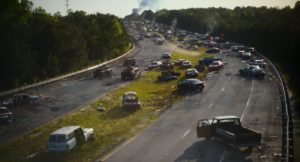Tropic Sprockets / Civil War
By Ian Brockway
 Like Steven Spielberg or Stephen King, Alex Garland (Men) manages to get at the nerves of our collective psyche and produce anxiety and very real discomfort. Garland’s latest film “Civil War” conjures unease again very effectively, although I am unsure of its lasting power. [Showtimes at Tropiccinema.com.]
Like Steven Spielberg or Stephen King, Alex Garland (Men) manages to get at the nerves of our collective psyche and produce anxiety and very real discomfort. Garland’s latest film “Civil War” conjures unease again very effectively, although I am unsure of its lasting power. [Showtimes at Tropiccinema.com.]
The film focuses intensely on the American universal nightmare of recent days: a civil war. There is no mentioned instigator or cause of the war, but one can infer given the hints, that it has to do with cultural differences of opinion and the fear of immigration. Suffice to say, communication and understanding has broken down between the United States, and the country is fighting an angry and very gory war, thick and toxic with human blood, divided into four sections.
Lee (Kirsten Dunst) is a journalist determined to get any impactful photo and Joel (Wagner Moura) is a partner. During a bomb incident, Lee befriends Jessie (Cailee Spaeney) a young girl who has aspirations to become a photographer.
Lee and Joel have an idea to travel to Washington across state lines, to photograph the president. Jessie agrees to come along. Lee’s mentor Sam (Stephen McKinley Henderson) accompanies them.
Like an Armageddon crew in a ghostly land of destruction and fear, the three people slowly drive their way to D.C. and there is nothing scarier than an empty house or a wide tree-lined road. The apprehension that the camera delivers is almost unbearable. Machine guns and military encampments that resemble angry boils are ubiquitous. Combat occurs without warning.
In the film’s most visceral sequence, a xenophobic nationalist (Jesse Plemons) terrorizes the group with a jarring sadism.
The film is a shocking sensory experience. The imagery including one scene with the young Jessie in a pit of murdered corpses almost overwhelms, both bringing to mind people calcified into fossils of pain and human beings discarded and thrown away— an immense field of gory laundry. Such scenes speak of poetry, sad and profane. The gunshots are given in sharp retort, glibly without sentiment. This is a place without language where gray machinery is menacing and forbidding. These segments are vivid and complete and expertly place the panic.
The march of fatigue and a syncopation of bloodcurdling screams, however, for the most part is all we get. Bombs blast with seat jumping intensity and bodies pile on. Little is offered as to the feelings of Joel or Lee. What do they feel about themselves as human beings? By the latter part of the film, the bombings and the firefights seem rote and arbitrary. The imagery is visceral and emotive, certain to provoke. Yet the final gunshot feels too conscious and self-aware, a cynical punctuation mark.
This film is stirring, eerie and nerve-jangling as a deadly diorama, but there is not much here behind the camouflage.
Write Ian at [email protected]
[livemarket market_name="KONK Life LiveMarket" limit=3 category=“” show_signup=0 show_more=0]

No Comment